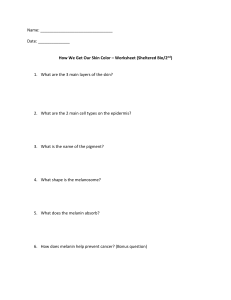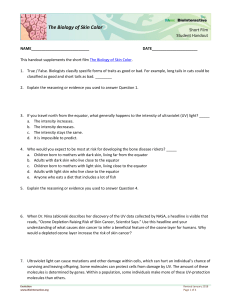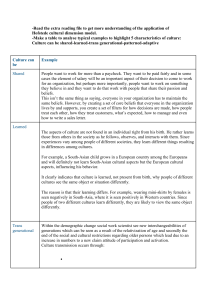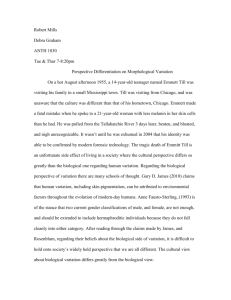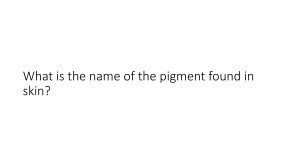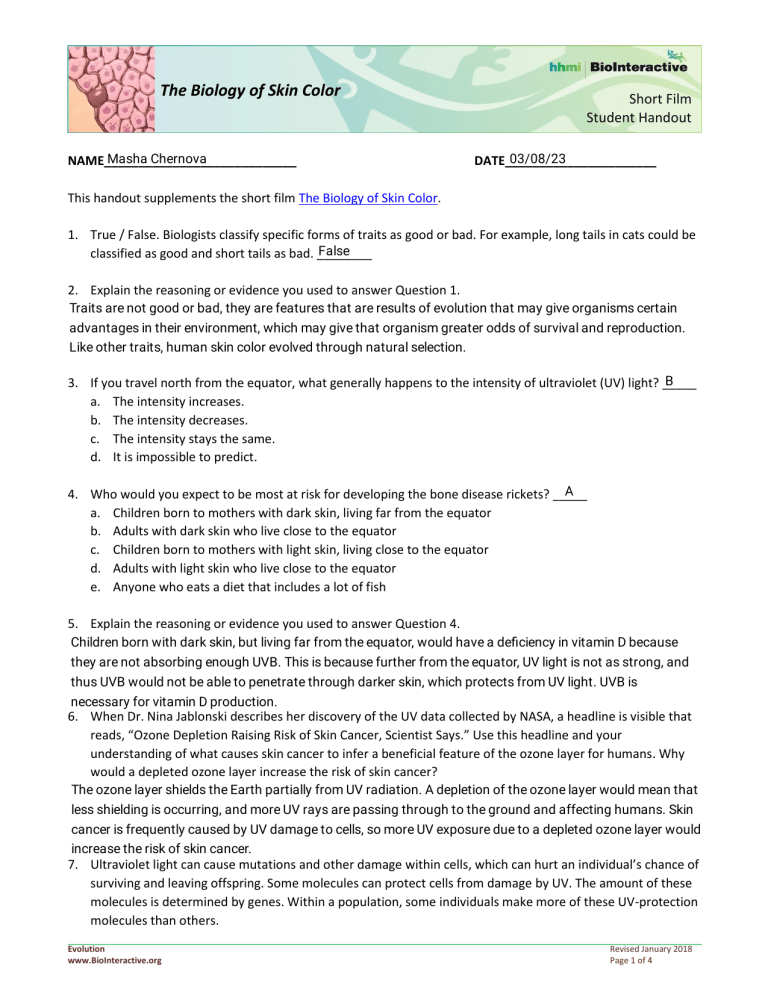
The Biology of Skin Color Masha Chernova NAME____________________________ Short Film Student Handout 03/08/23 DATE______________________ This handout supplements the short film The Biology of Skin Color. 1. True / False. Biologists classify specific forms of traits as good or bad. For example, long tails in cats could be False classified as good and short tails as bad. ________ 2. Explain the reasoning or evidence you used to answer Question 1. Traits are not good or bad, they are features that are results of evolution that may give organisms certain advantages in their environment, which may give that organism greater odds of survival and reproduction. Like other traits, human skin color evolved through natural selection. B 3. If you travel north from the equator, what generally happens to the intensity of ultraviolet (UV) light? _____ a. The intensity increases. b. The intensity decreases. c. The intensity stays the same. d. It is impossible to predict. A 4. Who would you expect to be most at risk for developing the bone disease rickets? _____ a. Children born to mothers with dark skin, living far from the equator b. Adults with dark skin who live close to the equator c. Children born to mothers with light skin, living close to the equator d. Adults with light skin who live close to the equator e. Anyone who eats a diet that includes a lot of fish 5. Explain the reasoning or evidence you used to answer Question 4. Children born with dark skin, but living far from the equator, would have a deficiency in vitamin D because they are not absorbing enough UVB. This is because further from the equator, UV light is not as strong, and thus UVB would not be able to penetrate through darker skin, which protects from UV light. UVB is necessary for vitamin D production. 6. When Dr. Nina Jablonski describes her discovery of the UV data collected by NASA, a headline is visible that reads, “Ozone Depletion Raising Risk of Skin Cancer, Scientist Says.” Use this headline and your understanding of what causes skin cancer to infer a beneficial feature of the ozone layer for humans. Why would a depleted ozone layer increase the risk of skin cancer? The ozone layer shields the Earth partially from UV radiation. A depletion of the ozone layer would mean that less shielding is occurring, and more UV rays are passing through to the ground and affecting humans. Skin cancer is frequently caused by UV damage to cells, so more UV exposure due to a depleted ozone layer would increase the risk of skin cancer. 7. Ultraviolet light can cause mutations and other damage within cells, which can hurt an individual’s chance of surviving and leaving offspring. Some molecules can protect cells from damage by UV. The amount of these molecules is determined by genes. Within a population, some individuals make more of these UV-protection molecules than others. Evolution www.BioInteractive.org Revised January 2018 Page 1 of 4 Short Film Student Handout The Biology of Skin Color What do you predict would happen to the frequency of the genes that cause more of the molecules to be made B in a population over time? Assume all other factors are equal. ______ a. The frequency would increase because individuals need the genes. b. The frequency would increase because individuals with the genes for more molecules would leave more offspring. c. The frequency would decrease because molecules are types of chemicals, and having more chemicals in the body is harmful. d. The frequency would stay the same because populations do not change over time. 8. Write down the evidence or reasoning you used to answer Question 7. Since some molecules protect from damage by UV, which can cause mutations and damage within cells that hurt an individual's chance of surviving and reproducing, the frequency of the genes that are responsible for the production of these molecules would increase over time because those with more of these molecules are more likely to survive and reproduce. If more people with the genes for these molecules reproduce, the population frequency of the gene will increase. 9. Describe your ideas about why indigenous groups of people in different parts of the world have different skin colors from other groups of people. Certain skin colors give certain advantages in different parts of the world. As indigenous groups of people have evolved in their respective locations, their population would have developed a greater frequency of genes that give an evolutionary advantage. In some regions, darker skin colors give an evolutionary advantage, so groups in those regions evolved to have darker skin color, while groups in other regions did not need to since darker skin did not possess an evolutionary advantage. Thus, people from different parts of the world have different skin colors due to natural selection and evolution. 10. Describe at least three different types of evidence that support your ideas for Question 9. 1. UV radiation levels vary around the world; they are greater around the equator and at high elevation 2. Exposure to UV radiation causes mutations and damage to cells, sometimes lowering the chances of an individual's survival/ability to reproduce 3. Melanin is a product of genetics that protects from UV light, and thus has an evolutionary advantage for those who are more exposed to higher levels of UV radiation A biologist was studying two indigenous groups of people from different areas of the world. The first population was from equatorial Africa. The second population was from northern Europe. The biologist was studying a gene that affects skin color. The biologist examined the gene in 100 people from each population. She kept track of how many different forms (or alleles) of the gene she found in each population. The results are in the graph in Figure 1. Number of Different Alleles of the Gene Use the following scenario to answer Questions 11 and 12. Figure 1. Evolution www.BioInteractive.org 18 16 14 12 10 8 6 4 2 0 Population 1 (equitorial Africa) Population 2 (Northern Europe) Revised January 2018 Page 2 of 4 The Biology of Skin Color Short Film Student Handout 11. Describe the major pattern in the data in Figure 1. People in population 2, from Northern Europe, usually had a much higher number of different allelles of this particular gene than those from population 1, in equatorial Africa. 12. Make a claim about the strength of stabilizing natural selection on this gene in the two populations. Use evidence from the graph (Figure 1) to support your claim. This gene is naturally selected for in areas of the world that do not have strong exposure to UV light. This is evident in the graph since population 2 - from Northern Europe - had a higher average number of different alleles of the gene as compared to population 1 - from equatorial Africa. In Northern Europe, exposure to UV light is much weaker than in equatorial Africa. 13. Describe how having dark skin may have provided an advantage in survival and reproduction to people thousands of years ago in some places in the world but not in others. Dark skin is a result of having more melanin in your skin cells. Melanin is a pigment produced by your body that reflects certain wavelengths of light, including UV light. In some places around the world, more melanin/a different type of melanin is necessary to protect from excessive UV light exposure; this is especially prevalent around the equator. UV light exposure can cause mutations and damage in cells, as well as birth defects, so in areas where there is a lot of UV light, a different type of melanin/more melanin production if favored because it offers more protection from UV light. In these areas, darker skin does not cause an evolutionary disadvantage due to lack of vitamin D since UVB can still get through darker skin due to stronger UV light. 14. Biologists sometimes say that “natural selection depends on the specific environment where a species lives.” B What does this statement mean? _______ a. If populations of a species are in different environments, traits that individuals need to meet their needs in each environment will appear. b. Traits can be helpful or harmful. If populations of a species are in different environments, some traits that are helpful in one environment might be harmful in another environment. c. Traits are always either helpful or harmful, and the environment of a population doesn’t matter. If populations of a species are in different environments, the same traits will always be helpful. d. Species were formed to perfectly match their environment. The traits of individuals in a species depend on the specific environment in which they were created. 15. Describe how UV light is harmful to people but can also be necessary. UV light is known to be able to cause dangerous mutations within human cells and damage them severely. Exposure to UV light is a common cause of skin cancer. However, a part of UV light called UVB is critical in helping the human body produce vitamin D. Without vitamin D, humans are unable to absorb calcium from our diets; absorbing calcium is vital for our bones and immune system. Around the equator, having darker skin protects from UV light damage, while still allowing for enough UVB absorption. However, in areas further away from the equator, darker skin would prevent UVB absorption Evolution www.BioInteractive.org Revised January 2018 Page 3 of 4 Short Film Student Handout The Biology of Skin Color 16. How does the synthesis of melanin by melanocytes help these cells with their major function in skin? In cells, folate is a molecule that is necessary not only for correct embryonic development but also for vitamin D production. Exposure of cells to UV light can damage folate, causing birth defects or vitamin D deficiency. Synthesis of melanin helps protect cells from UV light damage, thus protecting folate and ensuring that cells can function normally. Also, melanin's protection from UV light lowers the risk of skin cancer, since UV can cause damage and mutations. 17. The graph in Figure 2 summarizes the age at which people are diagnosed with melanoma, the most serious form of skin cancer. Use the graph to explain why protection from skin cancer may not explain the strong selective pressure for dark skin in high-UV areas. Figure 2. Although a benefit of melanin is protection from skin cancer due to UV light exposure, this does not necessarily explain why populations that are exposed to more UV light have evolved to have darker skin, which has a different, more protective type of melanin. This is because normally, natural selection, which was assumed to be the cause of different skin colors around the world, works to increase an individual's chance of reproducing. However, it is evident from the graph that skin cancer is most common in ages that are later than the age that humans would normally reproduce at, meaning that variation in skin color did not develop directly because of skin cancer, as skin cancer due to UV light would not necessarily impact reproduction, and thus would not be naturally selected for if not for other factors. An additional factor that was explained in the video was the fact that UV light seems Evolution www.BioInteractive.org Revised January 2018 Page 4 of 4
